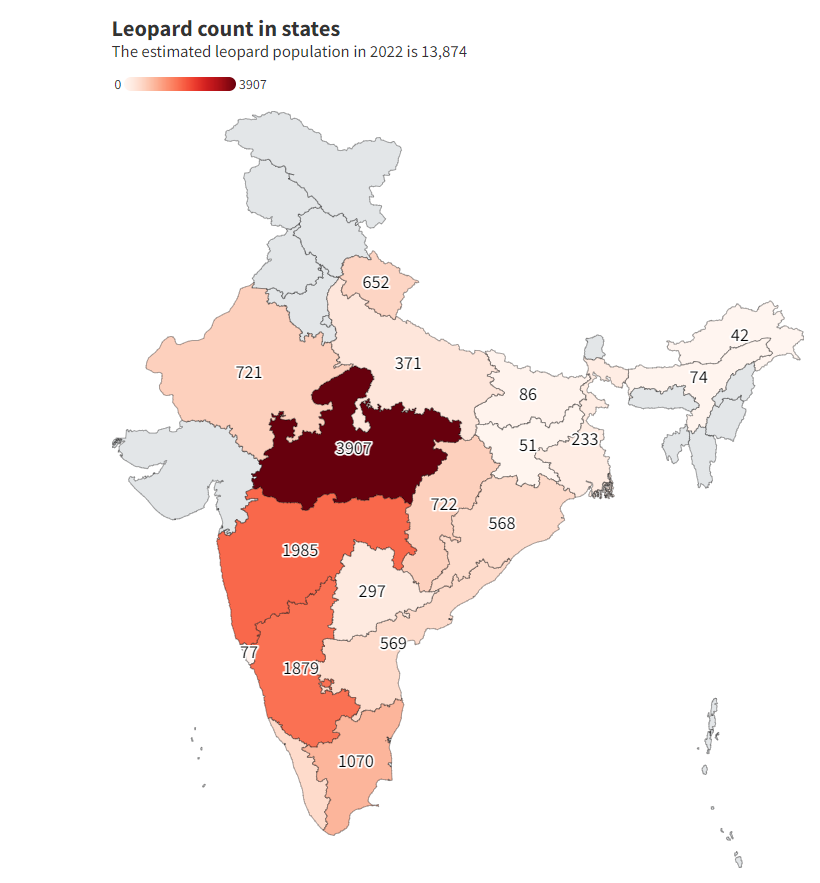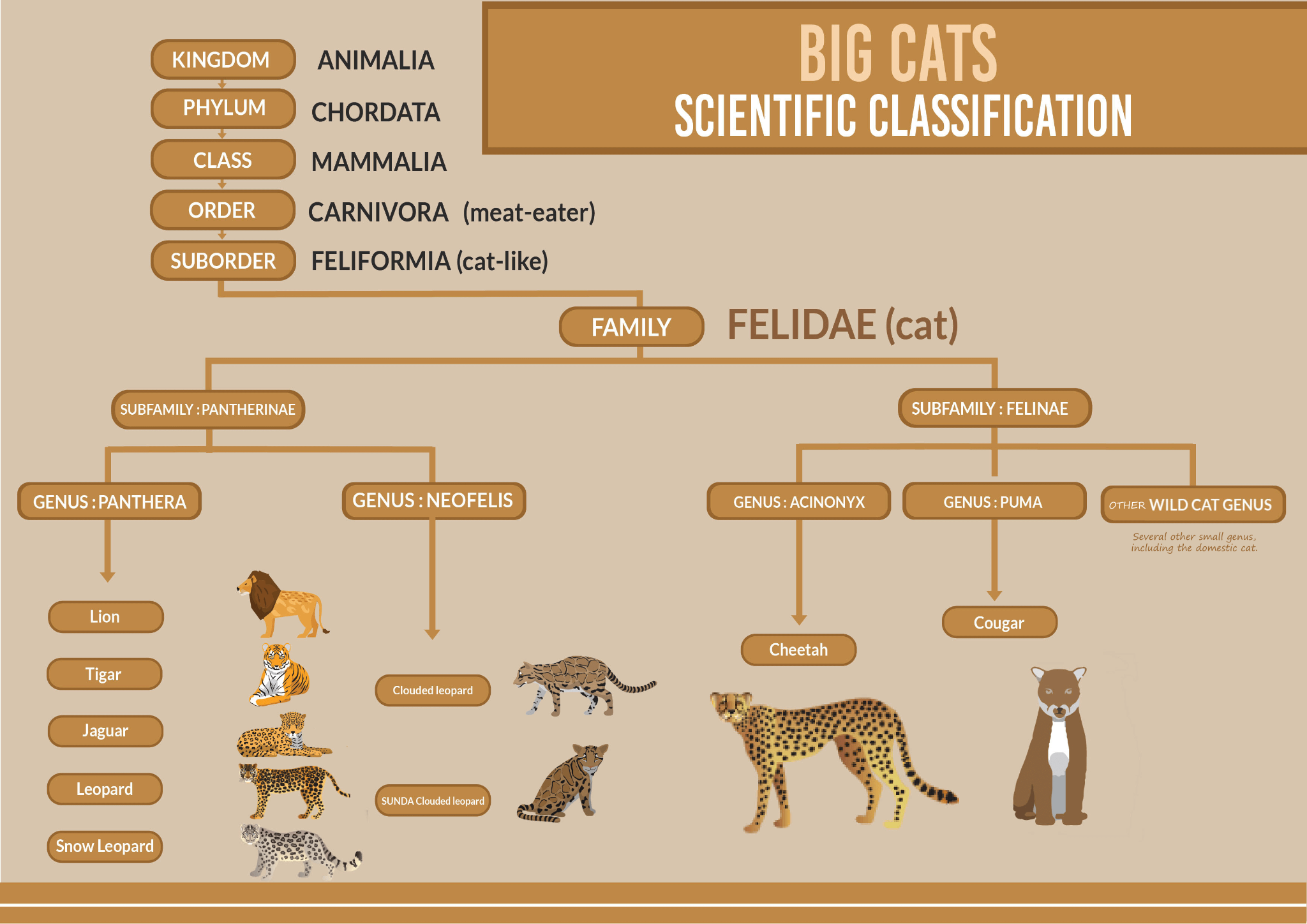Biodiversity & Environment
Status of Leopards in India 2022
- 04 Mar 2024
- 7 min read
For Prelims: International Big Cat Alliance, Tigers, Lions, Leopards, Snow Leopards, pumas, jaguars, Sustainable Development Goals (SDGs).
For Mains: International Big Cat Alliance, Conservation.
Why in News?
The Ministry of Environment, Forest and Climate Change has released a report on the Status of Leopards in India 2022. The survey covered 20 States of India, and focussed on about 70% of the animals’ expected habitat.
- Recently, the Union Government, while commemorating the 50th anniversary of Project Tiger, has approved the establishment of the International Big Cat Alliance (IBCA) with headquarters in India with a one-time budgetary support of Rs.150 crore for a period of five years from 2023-24 to 2027-28.
What are the Key Highlights of the Report on the Status of Leopards in India 2022?
- Overall population:
- India's leopard population rose by 8% from 12,852 in 2018 to 13,874 in 2022.
- About 65% of the leopard population is present outside protected areas in the Shivalik landscape. Only about a third of the leopards are within protected areas.
- The Shivalik landscape refers to the outermost range of the Himalayas, known as the Shivalik Hills or the Shivalik Range. This range extends across several states in northern India, including Uttarakhand, Himachal Pradesh, Haryana, Punjab, and parts of Jammu and Kashmir and Uttar Pradesh.
- Regional variation:
- Central India shows a stable or slightly growing population of leopards (2018: 8071, 2022: 8820), Shivalik hills and Gangetic plains experienced decline (2018: 1253, 2022: 1109).
- In Shivalik hills and Gangetic plains, there is a 3.4% decline per annum, while the largest growth rate was in Central India and Eastern Ghats of 1.5%.
- Central India shows a stable or slightly growing population of leopards (2018: 8071, 2022: 8820), Shivalik hills and Gangetic plains experienced decline (2018: 1253, 2022: 1109).
- State-level distribution:
- Madhya Pradesh has the highest number of leopards (3,907), followed by Maharashtra, Karnataka, and Tamil Nadu.
- In Odisha the number of leopards dropped from 760 in 2018 to 562 in 2022, and in Uttarakhand, the population declined from 839 in 2018 to 652 in 2022.
- Kerala, Telangana, Chhattisgarh, Bihar, and Goa too reported population declines.
- Madhya Pradesh has the highest number of leopards (3,907), followed by Maharashtra, Karnataka, and Tamil Nadu.
- Benefits From Tiger Conservation Efforts:
- The Central India and Eastern Ghats landscape is home to the largest population of leopards, which is growing due to protective measures within the framework of tiger conservation.
- The report highlights that leopard densities are higher in Tiger Reserves compared to areas outside Protected Areas, despite the regulatory pressure exerted by tigers on leopards.
- Common Threats:
- Common threats are poaching of prey for bush meat, targeted poaching for tiger and leopard skins and body parts and habitat loss due to mining and other human activities.
- In Odisha, as many as 59 leopard skins were seized from wildlife smugglers between 2018 and 2023.
- Additionally, road accidents are a significant cause of leopard fatalities.
- Common threats are poaching of prey for bush meat, targeted poaching for tiger and leopard skins and body parts and habitat loss due to mining and other human activities.
What is the International Big Cat Alliance (IBCA)?
- About:
- The IBCA is a multi-country, multi-agency coalition aimed at conserving big cat species and their habitats.
- It brings together 96 big cat range countries, non-range countries interested in big cat conservation, conservation partners, scientific organizations, and businesses.
- Objective:
- The primary goal of the alliance is to collaborate on efforts to secure the future of big cats, including Tigers, Lions, Leopards, Snow Leopards, pumas, jaguars, and cheetahs, and the landscapes they inhabit.
- IBCA would work towards mitigating the adverse effects of climate change. It will advocate for policy initiatives that align biodiversity conservation efforts with local needs and contribute towards the attainment of United Nations-mandated Sustainable Development Goals within member countries.
- Structure:
- The grouping’s structure will consist of an Assembly of Members, a Standing Committee and a Secretariat, with its headquarters in India.
- Conservation Efforts of India:
- Project Lion
- Project Leopard
- Cheetah Reintroduction Project
- Wildlife Protection Act, 1972
- Snow Leopard Conservation:
- Conservation efforts include habitat protection, community engagement, research, and anti-poaching measures.
- Collaboration with neighbouring countries and international organizations helps in safeguarding this high-altitude predator.
What are the Key Points Related to Leopards?
- Scientific Name: Panthera pardus
- About:
- The leopard is the smallest of the Big Cat family (of genus Panthera namely the Tiger, Lion (Panthera leo), Jaguar, Leopard, and Snow Leopard), and is known for its ability to adapt in a variety of habitats.
- A nocturnal animal, feeds on smaller species of herbivores found in its range, such as the chital, hog deer and wild boar.
- Melanism is a common occurrence in leopards, wherein the entire skin of the animal is black in colour, including its spots.
- A melanistic leopard is often called a black panther and is mistakenly thought to be a different species.
- Habitat:
- It occurs in a wide range in sub-Saharan Africa, in small parts of Western and Central Asia, on the Indian subcontinent to Southeast and East Asia.
- The Indian leopard (Panthera pardus fusca) is a leopard widely distributed on the Indian subcontinent.
- It occurs in a wide range in sub-Saharan Africa, in small parts of Western and Central Asia, on the Indian subcontinent to Southeast and East Asia.
- Threats:
- Poaching for the illegal trade of skins and body parts.
- Habitat loss and fragmentation
- Human-Leopard conflict
- Conservation Status:
- IUCN Red List: Vulnerable
- CITES: Appendix-I
- Indian Wildlife (Protection) Act, 1972: Schedule-I
UPSC Civil Services Exam, Previous Year Questions (PYQ)
Q. Consider the following: (2012)
- Black-necked crane
- Cheetah
- Flying squirrel
- Snow leopard
Which of the above are naturally found in India?
(a) 1, 2 and 3 only
(b) 1, 3 and 4 only
(c) 2 and 4 only
(d) 1, 2, 3 and 4
Ans: (b)








